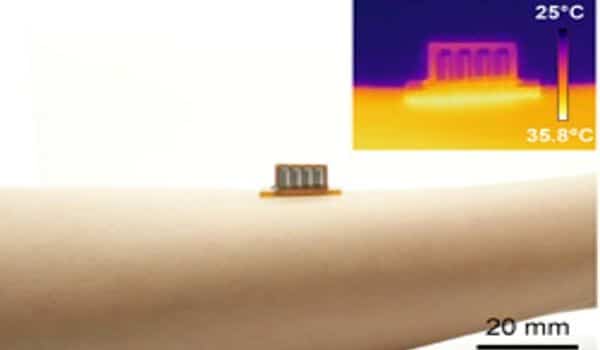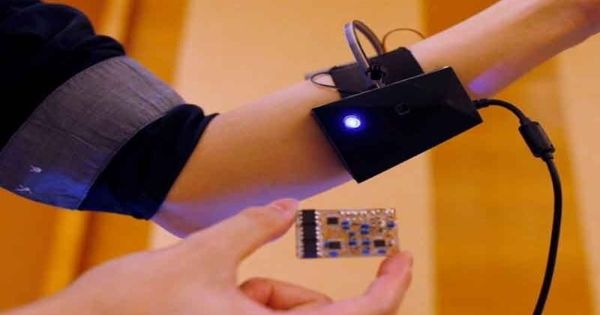A team of engineers has invented a new gadget that you can wear like a ring or a bracelet, and that absorbs energy from your body’s heat. Researchers at Colorado Boulder University have created a new low-cost wearable technology that turns the human body into a biological battery.
The gadget mentioned in Science Advances is stretchy enough that you can wear it like a ring, a bracelet or some other necklace that touches your skin. It also taps into a person’s own heat-using thermoelectric generators to turn the body’s internal temperature into electricity.
Researchers at CU Boulder have developed a new, low-cost wearable device that transforms the human body into a biological battery.
“In the future, we want to be able to power the portable devices without the need for a charger,” said Jianliang Xiao, senior author of the new paper and associate professor at the Paul M. Rady Department of Mechanical Engineering at CU Boulder.
The idea may sound like something from the Matrix film series, in which the robot race has enslaved humans to extract their precious organic resources. Xiao and his team are not that ambitious; they can produce around 1 volt of electricity per square centimeter of skin space—less voltage per area than most current batteries have, but still enough to power electronics like watches or fitness trackers.
Many researchers are working in this area, but Xiao says that his team equipment is different because it is lightweight, self-healing and completely recyclable. It is estimated that the unit produces around 1 volt of energy for every square centimeter of skin space. Not as many as the latest batteries, but enough to fuel a lot of watches or activity trackers. “We are working to make our systems as inexpensive and secure as possible, but still getting as close to zero environmental effects as possible,” said Xiao.

Scientists have previously worked with similar thermoelectric wearable devices, but Xiao is stretchy, can repair itself when injured, and is entirely recyclable-making it a safer alternative to conventional electronics. “If you use the charger, you can deplete the battery and finally need to refill it,” said Xiao. “The good thing about our thermoelectric system is that you can wear it, and it gives you constant strength.”
High-tech bling
The project is not Xiao’s first effort to meld humans with robots. He and his colleagues have previously worked with the concept of “electronic clothing,” interactive gadgets that look and act like actual human skin. However, this android epidermis must be wired to an external power source to function.
Until now, the new invention of the company has started with a foundation made of stretch material called polyimine. The scientists then stick a series of thin thermoelectric chips to the middle, attaching them all to liquid metal wires. The end result looks like a cross between a silicone bracelet and a mini machine motherboard, or maybe a technical diamond ring. “Our architecture makes the whole device stretchable without putting a lot of pressure on the thermoelectric material that can be very brittle,” Xiao said.
Just pretend you’re going for a stroll. When you workout, your body heats up, and the heat radiates out into the cold air surrounding you. Xiao’s unit catches the flow of energy rather than letting it go to waste. “The thermoelectric generators are in direct contact with the human body and can use the heat that would usually dissipate into the atmosphere,” he said.
Lego blocks
He added that you can quickly raise that power by adding more generator blocks. In this way, he compares his concept to a common children’s toy. “All I would do is merge these smaller units to get a larger unit,” he said. “It’s like bringing together a lot of little Lego pieces to make a huge frame. It offers you a lot of customization choices.”
For example, Xiao and his colleagues determined that a person taking a short walk will be able to use a gadget the size of a normal sports wristband to produce around 5 volts of electricity—more than many watch batteries would assemble.
Like the electronic skin of Xiao, the new systems are as durable as the biological tissue. When your system tears, for example, you should pinch the split ends together, and they’ll be sealed together in just a few minutes. And when you’re finished with the device, you can dive it into a special solvent that will separate the electronic components and dissolve the polyimine base—and then each and every ingredient can be reused.
“We are working to make our systems as inexpensive and secure as possible, but still getting as close to zero environmental effects as possible,” said Xiao. Xiao said that while there are still changes to be made, he expects that the products will appear on the market in five to ten years. While there are still kinks to iron out in the design, he thinks that his group’s products will be on the market in five to ten years. Only don’t mention anything to the robots. We don’t want them getting any ideas.
The co-authors of the new paper include scholars from China’s Harbin Institute of Technology, Southeast University, Zhejiang University, Tongji University, and Huazhong University of Science and Technology.















